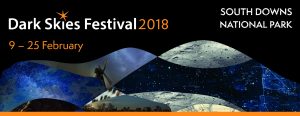Planning for Dark Night Skies
January 22, 2018
In 2016 the South Downs National Park became an International Dark Sky Reserve (IDSR). With properly dark skies in the South East of England under threat, this is a statement that our skies are worth protecting. The South Downs Local Plan sets out to do just that.
This February we’ll be celebrating our International Dark Sky Reserve status with our second South Downs Dark Skies Festival. We think our star-studded skies overhead are as valuable as our beautiful rolling landscapes so we’re taking steps to protect and enhance them through the Local Plan.
Local Plan Policy SD8: Dark Night Skies sets out a hierarchy for new development. Wherever possible new development will be required to avoid installing lighting. If new lighting is unavoidable steps must be taken to avoid its impacts on our dark night skies by making sure that it’s properly designed, taking into consideration direction of lighting and number of lumens emitted. If that is not possible, adverse impacts of lighting will be required to be mitigated – for example, by installing timing restrictions and making sure that the light emitted is of a colour that won’t disturb wildlife.
There is also a spatial element to the policy, with different criteria being applied in different areas of the National Park according to their sensitivity to new lighting. For developments outside the National Park’s urban areas, a maximum lux level for new lighting is proposed. A Dark Sky Core area, which all development must protect, is identified. This is based on the areas with the darkest skies in the National Park. A two kilometre buffer zone surrounds the core area. Appropriate curfews and timings for new lighting will be applied spatially across these zones.
 Appreciate the quality of our skies for yourself at the South Downs Dark Night Skies Festival from 9 – 25 February
Appreciate the quality of our skies for yourself at the South Downs Dark Night Skies Festival from 9 – 25 February
